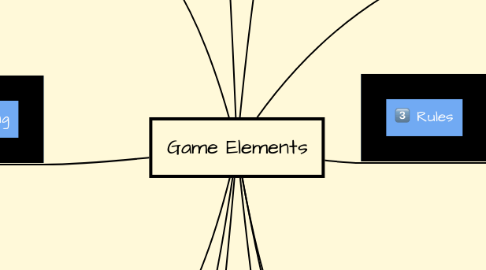
1. Storytelling
1.1. Story provides relevance and adds meaning, provides context, and guides the action
1.2. Story Elements
1.2.1. Characters
1.2.2. Plot
1.2.3. Tension
1.2.4. Resolution
1.3. The Hero's Journey
1.3.1. Common structure
2. Feedback
2.1. Real Time Feedback
2.1.1. On progress towards goal
2.1.2. Amount of life or energy left
2.1.3. Time remaining
2.1.4. How much stuff in inventory
2.1.5. Other players' progress
2.2. Informational Feedback
2.2.1. Tells the learner whether they did the correct thing or not
2.2.2. Doesn't tell them how to fix it
2.3. Guidance Feedback
2.3.1. Points the player in the right direction
2.4. Juicy Feedback Characteristics
2.4.1. Tactile
2.4.2. Inviting
2.4.3. Repeatable
2.4.4. Coherent
2.4.5. Continuous
2.4.6. Emergent
2.4.7. Balanced
2.4.8. Fresh
3. Levels
3.1. Different Types
3.1.1. Game Levels
3.1.1.1. Keep game space manageable
3.1.1.2. Well designed progression of levels should:
3.1.1.2.1. Progress the narrative
3.1.1.2.2. Build and reinforce skills at each level
3.1.1.2.3. Have levels that serve as motivation
3.1.2. Playing Levels
3.1.2.1. Too easy or too difficult games are not fun
3.1.2.2. Usually three levels
3.1.2.2.1. Easy, intermediate, and difficult entry levels
3.1.2.2.2. Demonstration, practice, and test modes
3.1.3. Player Levels
3.1.3.1. Players gain experience as they move through a game
3.1.3.1.1. Accumulate experience points (XP)
4. Curve of Interest
4.1. Flow and sequence of events that maintain players interest
4.2. The Hook
4.2.1. Grabs the learner and gets them excited
4.2.1.1. E.g., Case study
4.2.1.2. E.g., Mystery
4.3. Settle Down to Business
4.3.1. The learners interest should peak and rise throughout
4.4. The Climax
4.4.1. Should leave the learner with lingering interest and knowledge learned
5. Aesthetics
5.1. Art, beauty, and visual elements
5.2. Part of every game
5.3. Can create an immersive environment
5.4. Often disregarded but very important
5.5. Can be simple or photorealistic
5.5.1. Avoid the uncanny valley
6. Replay or Do Over
6.1. Gives the player permission to fail
6.1.1. Failing with minimal consequences encourages exploration, curiosity, and discovery based learning
6.2. Gets the player to reconsider and approach things differently
6.3. If the player keeps failing, there is often a level down option
6.4. Winning without any failure lessens the feeling of accomplishment
7. Abstraction
7.1. Abstractions of Concepts and Reality
7.2. Operating Model
7.2.1. Can be hypothetical, imagined, or fictional
7.2.1.1. E.g., Dungeons and Dragons
7.2.1.2. E.g., Halo
7.3. Many Advantages
7.3.1. Minimizes complexity
7.3.2. Clear cause and effect relationships
7.3.3. Removes extraneous factors
7.3.4. Reduces required time
8. Goals
8.1. Difference between a game and play
8.2. Adds purpose, focus, and measurable outcomes
8.3. Are specific and unambiguous
8.3.1. E.g., Defeat the dragon or die
8.3.2. E.g., Solve the puzzle or not
8.4. Clear and visible
8.4.1. Visual understanding of goal provides incentive, feedback, and indication of progress
8.5. Need to be well structured and sequenced
9. Conflict, Competition, or Cooperation
9.1. Most games have all three elements
9.2. Conflict
9.2.1. Challenge provided by a meaningful opponent
9.2.1.1. To win, the player must defeat their opponent
9.2.1.1.1. Opponents can be opposite teams, individuals or the computer/game system
9.2.1.1.2. Inflict damage, score more points, or hinder progress
9.3. Competition
9.3.1. Opponents cannot impede eachother
9.3.2. Devote their attention to optimizing their own performance
9.3.2.1. Win by being faster, cleverer, or more skilled than opponents
9.4. Cooperation
9.4.1. Work with others to achieve mutually desirable and beneficial outcome
9.4.2. The social aspect that many players enjoy
10. Time
10.1. Timer
10.1.1. Counts down (or up) and spurs player action and forces them to work under pressure
10.2. Time Management
10.2.1. Player needs to allocate time between different activities
10.3. Time can be compressed to facilitate gameplay
11. Rules
11.1. Limit player actions and keep game manageable
11.2. Different Types
11.2.1. Operational Rules
11.2.1.1. Describe how the game is played
11.2.2. Constituative/Foundational Rules
11.2.2.1. Underlying formal sructures
11.2.2.1.1. E.g., Probabilities
11.2.3. Implicit/Behavior Rules
11.2.3.1. Etiquette rules
11.2.3.1.1. E.g., How to be a good sport
11.2.3.2. Usually not written
11.2.4. Instructional Rules
11.2.4.1. Rules we want the learner to know after the game is finished
12. Reward Structures
12.1. Have an integral role to play but should not be the focus of gamification
12.2. Adds purpose, focus, and measurable outcomes
12.3. Types of Rewards
12.3.1. Leaderboards
12.3.1.1. Gives bragging rights and social capital
12.3.2. Points
12.3.3. Extra abilities and prizes
12.3.4. Badges

